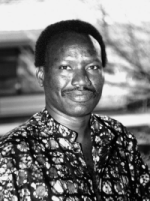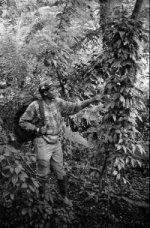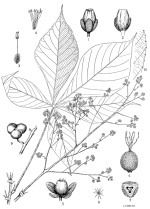Ethnobotanical
Portraits
Backgrounds

|
The plant motifs
for this issue of the Handbook
are taken from three plants that
form part of agroforestry systems
in diverse regions of the world:
a North African tree, and vines
from Africa and Southeast Asia.
/GJM |
| Vendor of sliced gnetum
leaves in a marketplace in
Yaoundé, Cameroon. Photo ©
Roger R.B. Leakey. |
Textures are woven with cane
from various species of Korthalsia
(Arecaceae), a genus that comprises
slender to robust high climbing rattans.
There are about 27 species of Korthalsia,
distributed from Burma and Indochina to
Papua New Guinea. Korthalsia is
characterized by basal suckers and
branching stems that create a tangle in
the forest canopy. The vines produce
excellent durable canes which, after
careful cleaning of the stem surface,
present an attractive reddish brown hue.
In Sabah, East Malaysia – where the
cane shown here was harvested – most
species of Korthalsia are highly
sought after for use in weaving and
basket making. In Central and East
Kalimantan, rattans in the genus Calamus
have been cultivated in agroforestry
systems for over one hundred years. The
Regional Office for Asia, the Pacific and
Oceania of the International Plant
Genetic Resources Institute (IPGRI-APO)
promotes conservation and use of bamboo
and rattan in Asian countries. In 1996,
IPGRI organized two training courses on
rattan in Sabah and Sarawak, Malaysia in
collaboration with INBAR, the
International Network on Bamboo and
Rattan, which is based in Beijing, China.
Contact: Dr. A.N.
Rao, Regional Office for Asia, The
Pacific and Oceania, International
Plant Genetic Resources Institute,
P.O. Box 236, UPM Post Office,
Serdang 43400, Selangor Darul Ehsan,
Malaysia; Tel. +60.3.9423891, Fax
+60.3.9487655, E-mail
n.rao@cgnet.com, Website http://www.cgiar.org/ipgri.
Leaves are harvested from Gnetum
africanum Welw. and G.
buccholzianum Engl. (Gnetaceae),
central and west African tropical forest
vines. The perennial foliage of these
gymnosperms – known as koko in
the Congo, eru in Cameroon and afang
or okazi in Nigeria –
is consumed in large quantities,
contributing up to 30% of the daily
intake of protein in some areas of
Africa. Women gather the gnetum leaves
and cut them into thin slices. These can
be eaten raw, but are usually served as a
side dish eaten with fufu, a
starchy staple made of cassava or maize.
Once a localized food, gnetum consumption
is now widespread. It is available as a
local specialty in restaurants and is
exported, especially to Belgium, France
and the United States of America. In the
Democratic Republic of Congo, Cameroon
and southeastern Nigeria, where average
daily consumption rates are high, wild
populations of the species are
threatened, especially as many plants are
uprooted to harvest the leaves. In
addition, leaf production rates are
relatively low, necessitating more
intensive production. Researchers at the
Limbe Botanical Garden in Cameroon,
through its ‘Conservation through
Cultivation’ program, have begun an
experimental project to domesticate and
improve varieties of gnetum for use in
agroforestry systems. This builds on
pioneering work by Patrick Shiembo, who
first discovered how to propagate the
vine from stem cuttings.
Contact: Mr. Joseph
Nkefor, Limbe Botanic Garden, P.O.
Box 437, Limbe, Cameroon; Tel./Fax
+237.431876, 431883 or 431885 Ext.
381, E-mail mcplbg@iccnet.cm.
Seeds are from Argania spinosa
(L.) Skeels, one of the few African
species of Sapotaceae that grow north of
the Sahara Desert. The tree is found from
sea level up to 1500 m in Morocco, where
it is known as the argan tree. An arid
zone plant, it can grow to a height of
eight to ten meters, with a diameter of
30 cm to one meter. A richly flavored,
nutty oil is extracted from the fruit. In
1878, Joseph Hooker and John Ball
described the Argan tree “as the
most interesting vegetable product of
Marocco [sic], being confined to that
empire and to a very circumscribed area
in it, belonging to an almost exclusively
tropical family, yielding a most
important article of diet to the
inhabitants, and a wood that for hardness
and durability rivals any hitherto
described”. Today argan oil is used
primarily in cooking and cosmetics. The
wood is used for timber and charcoal, and
the large leafy crown of the tree
provides livestock with fodder, and soils
with protective shade, making the argan a
valuable multipurpose tree for
agroforestry systems. The Union des
Coopératives des Femmes pour la
production et la commercialisation de
l’huile d’Argane et des
produits agricoles (UCFA) produces pure
traditional argan oil and other products
under the trade name
‘Tissaliwine’. Comprising four
cooperatives with over 150 woman, the
Union was created with support from GTZ.
The participating villages are within the
Arganerie Biosphere Reserve, officially
recognized by the UNESCO Man and the
Biosphere program in 1999.
Contact: Mr. Frank
K. Hayer, Argan Conservation and
Development Project, B.P 334, 80000
Agadir, Morocco;
Tel. +212.8.333880, Fax
+212.8.332973,
E-mail gtz-ARGA@mtds.net.ma.
 |
Left: Baskets with
roasted seeds and dried fruits of
argan. Above: Amlou (ground
almonds, honey and argan oil) and
argan oil prepared by the
‘Tissaliwine’
cooperative. |
Profiles
Amadou Ibra
Niang
 |
Amadou Ibra
Niang, who is from Senegal, has
worked at the International
Centre for Research in
Agroforestry (ICRAF) since 1989.
As Principal Forester, he is
responsible for planning and
conducting participatory
agroforestry research in Maseno,
western Kenya, and for
facilitating the wider
dissemination of promising
agroforestry innovations through
development partners. He is also
responsible for promoting links
between ICRAF and other research
institutions, as part of the
activities of the Agroforestry
Research Networks for |
Africa
(AFRENA) in eastern and central Africa.
Dr. Niang strives to link participatory
on-farm testing and development methods
to encourage farmers and community groups
to spread the word about sustainable
farming systems. He and his team have
been highly successful in Maseno, where
more than 6000 farmers are already using
agroforestry innovations for the
restoration of soil fertility developed
by ICRAF and its national partners.
Contact: Dr. Amadou
Ibra Niang, P.O. Box 25199, Otonglo,
Kisumu, Kenya; Tel. +254.2.521450,
Fax +254.2.521001,
E-mail icraf-maseno@x1.cgiar.org.
Joseph Poteh
Nkefor
 |
Joseph Poteh
Nkefor was born in Cameroon in
1964. Over the last five years,
he has worked on the
domestication of forest species
that yield non-timber forest
products, including indigenous
vegetables, medicinal plants and
rattans. As part of this research
he is conducting trials at the
Limbe Botanic Garden (LBC) on the
propagation, establishment and
harvesting of Gnetum. In
collaboration with the African
Rattan Research Program and the
Cameroon Development Corporation
(CDC), he is carrying out
germination trials of African
rattan species, leading to the
establishment of the first
African experimental rattan
plantation where growth rates and
morphological changes are
monitored. |
He has
also carried out research on seed
germination and storage of Prunus
africana, a commercialized medicinal
plant.
Drawing upon his skill
in collecting living plants and herbarium
specimens, and his ethnobotanical
knowledge, he has helped to develop the
Limbe Botanical Garden medicinal plant
beds. Experienced in supervising the
practical work of university and
professional students in subjects related
to botany and horticulture, he has
supervised the work of 12 students,
including some at the M.Sc. level. His
contacts are given on page 36 of this Handbook,
under the article on Gnetum.
What is
this.....?
Did you
recognize the plant scattered through
these pages?
 |
It is Ricinodendron
heudelotii (Baillon) Pax
(Euphorbiaceae), a tree of
tropical central Africa that has
a light and soft timber used for
drums and similar artefacts. The
trees are planted in agroforestry
systems primarily because they
yield kernels used as a food
flavoring and oil source. They
are exported from Cameroon to
neighboring countries in
considerable quantities. Roger
Leakey reports that the species
came out third in ICRAF’s
farmer-oriented priority setting
exercise for domestication of
trees in humid west Africa. |
The
illustration and part of the botanical
information are from Dale, I.R. and P.J.
Greenway. 1961. Kenya Trees and
Shrubs. London, Robert MacLehose and
Glasgow, University Press. The second
authoritative book of Kenyan trees
(following the 1936 reference text
The Trees and Shrubs of Kenya Colony),
it contains basic information on the uses
and preferred environments of many
species. A revision of the book in 1994
by Henk Beentje, entitled Kenya
Trees, Shrubs and Lianas, increased
the number of species covered from 1000
to 1800. It was published by National
Museums of Kenya and includes
reproduction of the illustrations in the
Dale and Greenway edition.
Contact: Dr.
Beatrice Khayota, Acting
Botanist-in-charge, East African
Herbarium, National Museums of Kenya,
P.O. Box 40658, Nairobi, Kenya;
Tel. +254.2.743513 or 742161, Fax
+254.2.741424,
E-mail plants@africaonline.co.ke or nmk@africaonline.co.ke,
Website http://www.museums.or.ke/.
|